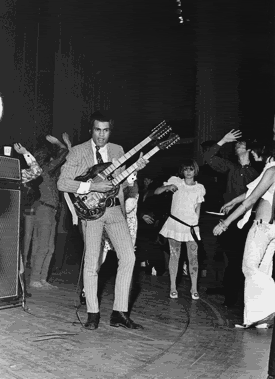~ By NATALIE NICHOLS ~

Photo Courtesy Domenic Priore
~ Revelation: Love guitarist Johnny Echols at the Hullabaloo in 1966 ~
I’m going down to the Strip tonight
I’m not on a stay-home trip tonight
Long hair seems to be the main attraction
But the heat is causing all the action …
–The Standells, “Riot on Sunset Strip”
That was the scene in November 1966, as police cracked down on teenagers protesting draconian enforcement of a curfew intended to keep them off the Sunset Strip. Along this magical stretch between Crescent Heights and Doheny, kids had thronged clubs like the Whisky a Go Go, Ciro’s, the Trip, and Pandora’s Box for nearly two years – mingling, dancing, and watching the Byrds, the Doors, Love, Buffalo Springfield, the Standells, and many other eventually iconic rock bands. It was a vibrant creative interlude that, as author Domenic Priore writes in his new book Riot on Sunset Strip (Jawbone Press, paper, $29.95), “has given our world immeasureable color and contributed to much positive social change.”
But, as conveyed by the brash guitar lead and howling sirens on the Standells’ theme to 1967 teensploitation flick Riot on Sunset Strip, the thrill of the new soon clashed with the will of the old. And, despite youth outrage and even parental objections, baton-wielding sheriff’s deputies quickly put a stop to the freewheeling fun.
Priore’s book – including a foreword by the late, great Arthur Lee of Love – arrives just as the popcult cuckoo clock heralds the 40th anniversary of the Summer of Love. (Gee, seems like just yesterday it was the 30th anniversary of the Summer of Love.) These repetitive milestones are tiresome, but the ’60s remain a fabled era of innovation and evolution. After all, back then a former Mouseketeer – namely, Standells singer-drummer Dick Dodd – could grow up to become a cool, socially conscious garage-rocker instead of an empty-headed product à la Britney, Justin, and Xtina. Riot reminds us that, in those days, teen culture was the tail that wagged the capitalist running-dogs, and not the other way around.
But mostly, the book demonstrates that Los Angeles was a virtually unparalleled ’60s crucible for the underground fusion of music, visual arts, and activism that flowered in mainstream culture during the Summer of Love. Priore conveys the excitement, as well as the turmoil, of change. Still, Riot has a pervasive sense of doom.
“I see this story as a tragedy,” says Priore, a longtime acquaintance who, full disclosure, includes me among the book’s long list of “those who helped” (although I’m not sure why). “And I think the most dismaying thing is how people perceive [that time] now: San Francisco was the god city, and Manson was what L.A. was about. I am hoping the book might change some of those opinions.”
An obsessive pop-culture historian whose 1995 Look! Listen! Vibrate! Smile! remains the definitive book about the Beach Boys’ legendary lost album Smile, Priore scoured old copies of the L.A. Free Press, culled info from liner notes, and tracked down vintage photos to create a vivid sense of time and place. His fascination with minutiae can be head-spinning, but the details make Riot a compelling exploration of the historical, political, racial, and cultural contexts affecting the Strip, and L.A. itself, as far back as the 1920s.
“It’s hard to capture the essence of a scene as a whole,” says the L.A. native, and that’s an understatement. He was only five in 1965 but caught occasional fleeting glimpses of the Strip from the family car, as well as hearing about it from older siblings who were there. He also saw many Strip bands on Shindig!, Hollywood a Go Go, and numerous other L.A.-based rock TV shows of the day. These memories fueled his curiosity about how this impromptu movement arose, and he works hard to show how various discrete local scenes – Chicano rock, Venice beats, rockabilly, surf, folk, R&B, as well as art movements, comedy, and film – crossed paths and cross-pollinated with the Strip scene, which was also fed by and in turn influenced such American heroes as Bob Dylan and British stars as the Rolling Stones.
The demise of it all is tragic indeed, but the “Aftermath” chapter may be more depressing, delineating how much the Strip has changed. When you look at the old photographs of the street, you can recognize the outline of what’s still there. But when you actually travel down the boulevard, no trace of those days remains.
Domenic Priore, with special guests Michael Stuart-Ware (former Love drummer) and Jim Lowe and Mark Tulin (of the Electric Prunes), appear at Book Soup, 8818 Sunset Blvd., West Hollywood, on Thur., July 12, at 7 p.m. (310) 659-3110 or Booksoup.com.
07-05-07
No comments:
Post a Comment